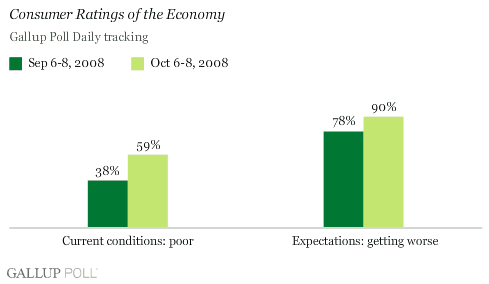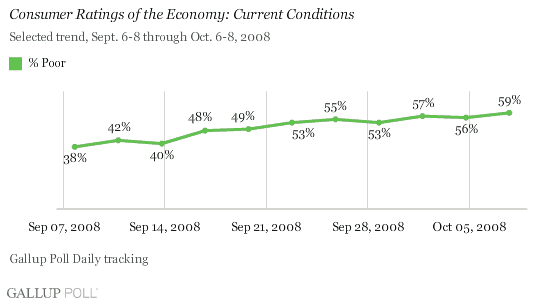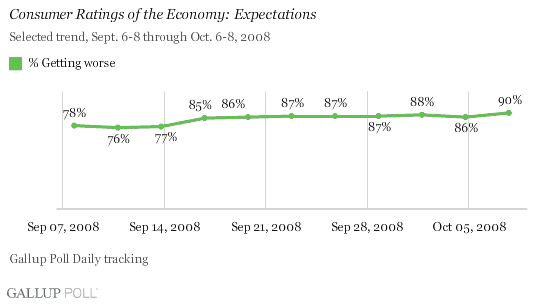PRINCETON, NJ -- Despite passage of the Treasury bailout and a global reduction in interest rates, consumer pessimism hit a new record high early this week, with the percentage of Americans rating the economy as "poor" increasing by 21 percentage points from a month ago and the percentage saying the economy is "getting worse" increasing by 12 points.

Percentage Rating Economy "Poor" Continues to Increase
Pointing to a variety of anecdotal evidence, many observers have noted that consumer spending seemed to hit a wall around mid-September. Gallup's daily measurement of consumer confidence tends to confirm these general perceptions. A month ago, around the time of the Fannie Mae/Freddie Mac bailout, 38% of consumers rated current economic conditions "poor." By the time of the Treasury's bailout proposal in mid-September, the percentage rating the economy poor had increased 15 points to 53%. Even with the congressional passage and president's signing of the Treasury proposal, consumer pessimism has continued to increase. Early this week, the percentage of Americans rating the economy "poor" hit a record new high of 59% -- up 21 points from the same time a month ago.

Percentage Saying Economy Is "Getting Worse" Continues to Increase
A month ago, 78% of Americans said current economic conditions were "getting worse," rather than better. By the time of the Treasury's proposal, 87% of Americans felt this way. Even with the president's signing of the Treasury's requested new emergency legislation, a record 90% of Americans now say the economy is "getting worse."

Commentary
The way the stock market has plunged this week, it appears investors share the growing consumer pessimism reflected in Gallup's daily polls.
The problem seems to be that the freeze-up of the credit markets and the debate over the Treasury bailout may have taken the crisis of confidence in the banking sector and on Wall Street to Main Street. And, as the Dow Jones Industrial Average plummets, Americans see their financial assets disappearing, on top of the losses they have already taken on the value of their homes.
It appears that passage of the Treasury's bailout proposal may have had at least a temporary positive effect on how much consumers are currently worrying about money. However, even the combined efforts of the Treasury, the Federal Reserve Board of Governors, and the Congress have, at least to this point, not been enough to shore up consumer confidence in the U.S. economy. In turn, plunging stocks and ever-increasing pessimism may mean that any reduction in money worries associated with adoption of this new legislation is short-lived at best.
Consumer psychology is much more fragile than many people tend to realize. Behavioral economics suggests that this is particularly the case when long-held assumptions about the safety of consumers' investments -- their overall perceptions of risk -- turn out to be wrong.
Gallup's polling suggests that consumer confidence is reaching historic lows. In turn, this suggests that consumers may pull back from spending, to a degree not seen in many decades. And unemployment is likely to increase sharply.
Given the current financial crisis and associated recession, it is likely to take some dramatic efforts to turn consumer confidence around. In a sense, the country may be lucky that the presidential election is only weeks away. No matter who is elected, the new president and Congress are likely to have an important opportunity to reinvigorate consumer confidence.
Survey Methods
Gallup is interviewing no fewer than 1,000 U.S. adults nationwide each day during 2008. The economic questions analyzed in this report are asked of a random half-sample of respondents each day. The results reported here are based on combined data from approximately 1,500 interviews for each three-day period of polling, conducted from Sept. 6-8 to Oct. 6-8, 2008. For results based on these samples, the maximum margin of sampling error is ±3 percentage points.
Interviews are conducted with respondents on land-line telephones (for respondents with a land-line telephone) and cellular phones (for respondents who are cell-phone only).
In addition to sampling error, question wording and practical difficulties in conducting surveys can introduce error or bias into the findings of public opinion polls.
